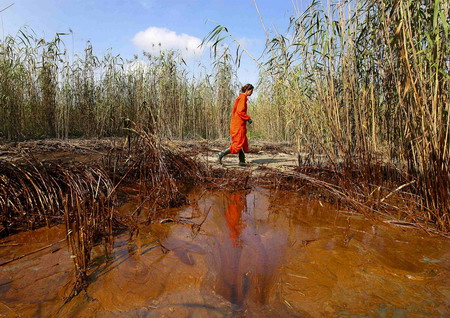Asia-Pacific
Heavy oil hits Louisiana's fragile marshland
(Agencies)
Updated: 2010-05-20 13:50
 |
Large Medium Small |
|
|
Heavy oil hits Louisiana shore, enters sea current
VENICE, La. -- The first heavy oil from a giant Gulf of Mexico spill sloshed ashore in fragile Louisiana marshlands on Wednesday and part of the mess entered a powerful current that could carry it to Florida and beyond.
The developments underscored the gravity of the situation as British energy giant BP Plc raced to capture more crude gushing from a ruptured well a mile (1.6 km) beneath the surface. The spill is threatening an ecological and economic disaster along the US Gulf Coast and beyond.
"The day that we have all been fearing is upon us today," Louisiana Governor Bobby Jindal said after a boat tour to the southernmost point of the Mississippi River estuary.
Officials had previously reported debris in the form of tar balls, or light surface "sheen" coming ashore in outlying parts of Louisiana, Mississippi and Alabama.
The marshes are the nurseries for shrimp, oysters, crabs and fish that make Louisiana the leading producer of commercial seafood in the continental United States and a top destination for recreational anglers. The United States has already imposed a large no-fishing zone in waters in the Gulf seen affected by the spill.
Meanwhile, the US government's top weather forecaster said a small portion of light sheen from the giant oil slick had entered the Loop Current, which could carry the oil down to the Florida Keys, Cuba and even up the US East Coast.
BP, its reputation on the line in an environmental disaster that could eclipse the 1989 Exxon Valdez spill in Alaska, has marked some progress at siphoning some of the oil from the well, which ruptured after an April 20 explosion of the Deepwater Horizon rig that killed 11 workers.
BP said it is now siphoning about 3,000 barrels (126,000 gallons/477,000 liters) a day of oil, out of what the company estimated was a 5,000 barrels (210,000 gallons/795,000 liters) a day gusher. The company could begin injecting mud into the well as early as Sunday in a bid to permanently plug the leak.
'Not Rocket Science'
A US congressional panel heard testimony from experts who said the spill rate could be many-fold larger.
"This is not rocket science," said Steve Wereley, associate mechanical engineering professor at Purdue University, who pegged the spill's volume at about 70,000 barrels per day. "All outside estimates are considerably higher than BP's."
BP Chief Operating Officer Doug Suttles said on Wednesday its 5,000-barrels-a-day estimate was "highly" uncertain.
BP shares closed down nearly 2 percent in London on Wednesday, extending recent steep losses.
Political fall-out also continues. The US Interior Department said on Wednesday its embattled Minerals Management Service will be broken up into three separate divisions, as part of an effort to restructure the way the department handles offshore energy production.
Top Democrats in the US Senate urged President Barack Obama to order immediate, enhanced inspections of all offshore oil rigs and production platforms.
And another company entered the fray. Schlumberger Ltd , the world's largest oilfield services company, said it had a crew on the Deepwater Horizon that departed only hours before the explosion and fire that engulfed the rig.
The company, which had not previously revealed its work on the Horizon, said in an e-mailed statement it performed wireline services for BP on the rig in March and April, completing the last services on April 15 and leaving a crew on standby in case any more were needed.




